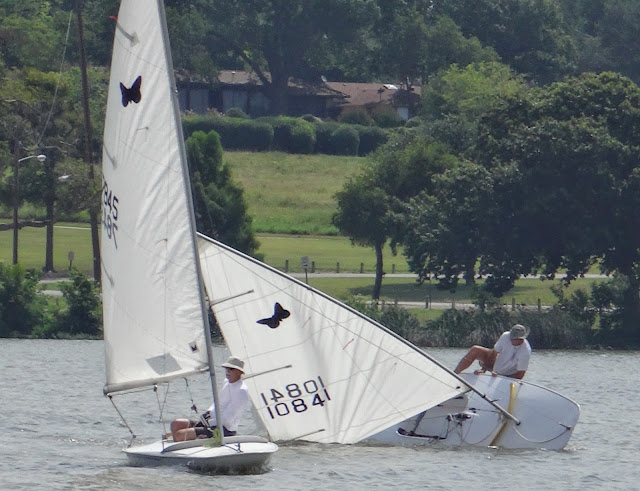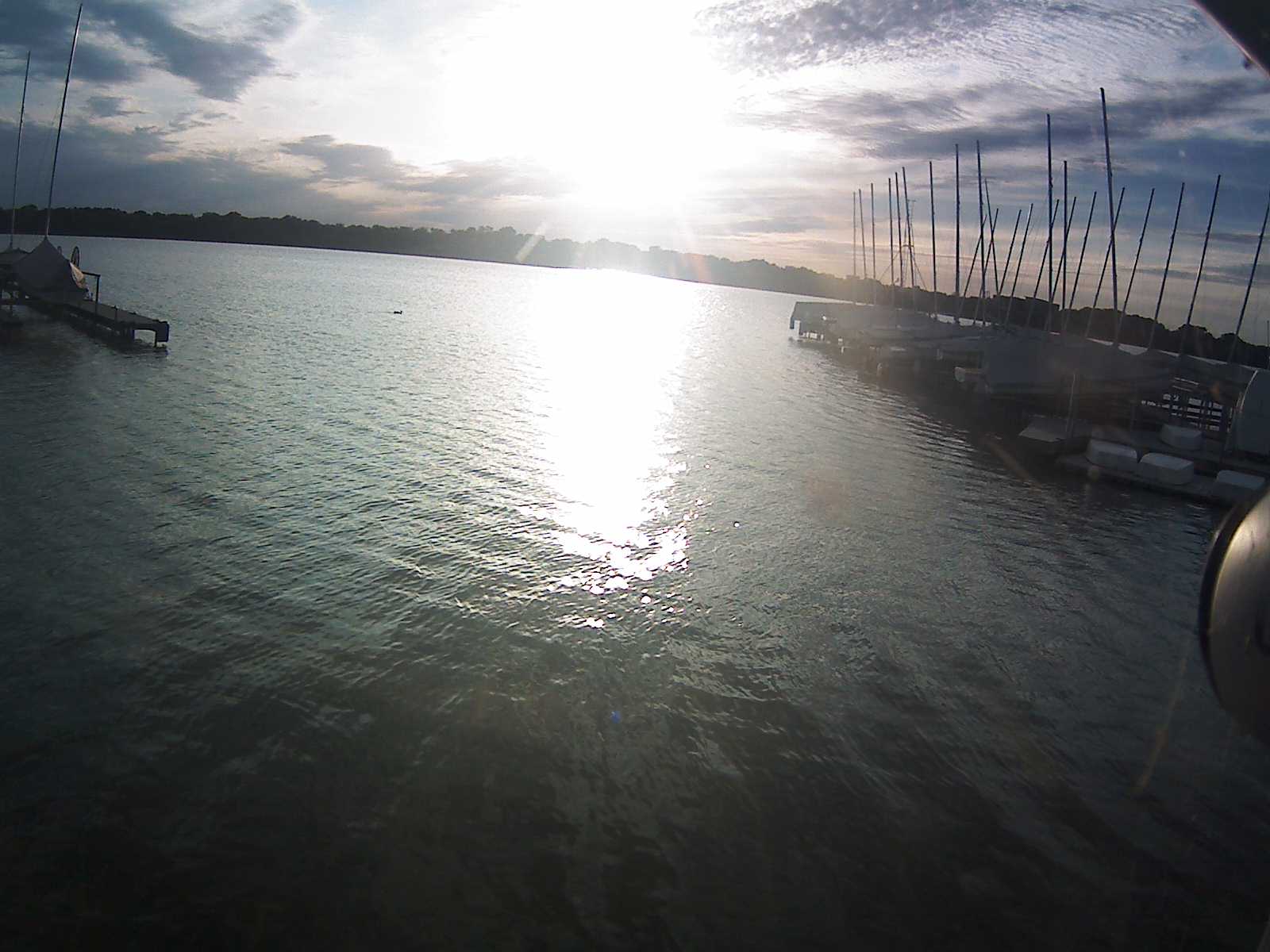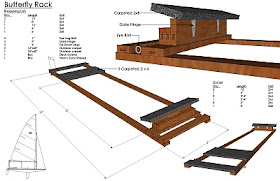Capsizing!
by Cathy
We had racing this past Saturday with about 10 Butterfly sailors out, nice in the morning but the wind seemed to dwindle and I think several of us bailed for the last race and I'm not sure if anyone went back out.
This blog is not about Saturday sailing. Sailboat racing is always fantastic just to be out on the lake with a great bunch of people and race committee out there taking care of us. Instead this blog is more about the art of capsizing and recovery. Unfortunately I am quite good at capsizing . . . but can't say too much about recovery. So, I'm inviting some comments of those who are better at recovery.
For capsizing I can say it happens in a variety of ways and my best chance of self recovering is if I can quickly jump over the high side out to the end of the dagger board and pop the boat back up, hopping in. An empty bottle at the top of the mast is very helpful in this situation as it may keep the mast on the top of the water. (A more elegant solution is the flotation panel that is sold specifically for the Butterfly.) If the mast sinks, it will most likely get stuck in the mud and just being on the dagger board will not help. Check it out. If Dave K. at his weight can't get the boat up, then it's unlikely you can either - which is when the committee boat has to come in and help.
| Awaiting rescue. |
 |
| Moving fast! |
Marshall also has a method which consists of taking the extra halyard from the mast and throwing it over, putting your feet on the bottom side of the hull and pulling the halyard. It's similar to the "righting line" concept for a catamaran. I tried it a few weeks ago and did get unstuck - but still couldn't get the boat up. And all of that struggling takes a lot of energy . . .
So, then what happens if you didn't move fast enough or the boat capsized in such a way that you just didn't have a chance to self-rescue? That's when the committee boat comes in. I'm going to suggest that the safest thing to do is to get the sailor into the committee boat first before trying to recover the boat. It's up to the parties involved - but unless you have good visibility and the water is warm - having everyone in the boat adds a margin of safety. When everyone is in the boat they can all help get the boat up - so then you have an extra set of hands on deck. It's also easier to step into the Butterfly instead of climbing over the side - especially if you have your life jacket on.
I'd like to hear what others have to say as far as suggestions for recovery by RC. Get the painter and pull the sailboat into the wind? Grab a side stay and pull the boat up? What's the best method or does it just depend on how the boat is stuck . . .
Capsizing is a part of sailboat racing! Let's get better at the recovery part.










8/01/2016 1:59 PM
After rescuing about 3-4/yr Bflys over 40+ years here is my added wisdom; -GaryE
See top photo how in medium-strong wind, unless you act quick, Bfly ends up with hull perpendicular to wind on a steep angle with the mast in the mud. The trick is to get the boat head to wind as soon as possible so the wind gets under the sail and lifts under it, assisting raising the mast.
If you carry flotation on top of mast you get some more time, but not much time as the wind on the hull drives the mast down and it fills with a lot of heavy (>5lbs)water. A hole a few inches from the bottom in the mast will let water drain out quickly upon righting. Right it slowly as once upright this weight in the mast will cause boat to turnover again.
The easiest method is to get the sailor in the rescue boat first for safety and rescue assistance, while securing the bow line, or added line, to center front of rescue boat. Then slowly back the rescue boat up against the wind (requires driving skill as tricky wind sails the rescue boat sideways). Using the bow line to swing the Bfly bow head to wind. As the Bfly bow comes around the wind gets under the sail. Once the boat is head to wind the boat should be pulled in and the the side stays lifted (gloves please) up on the bow of the rescue boat using the lift from the sail. Let the mast drain as the stays are lifted slowly, take our time. Don't turn loose, as the boat will keep moving and try to tip over in the opposite direction. Not good after your exhausted. Once righted, keeping the Bfly head to wind, pull the boat along side the rescue boat while backing so that the skipper can climb into it after the mast has drained. Don't release until all lines and equipment are accounted for and Bfly is sailable.
Look for the next rescue.
8/01/2016 4:28 PM
Wow - excellent advice and detailed instructions by Gary . .. Thank you, Gary!
Cameron and I discussed and so much depends on the conditions, skill of sailor, etc. He has done quite a few rescues of several types of boats and has the additional great suggestions:
1. The race committee has the liability, thus they have the authority to order the sailor aboard the motor boat. Plus they have a much better vantage to assess the situation. At some point when everyone’s tired, cold, hot or just sick of it...head to the dock, take a break and recover the boat with fresh eyes and hands. Call 911 and tell them a capsized boat is adrift so the subsequent well meaning citizen calls don’t prompt a fire dept. rescue.
2. When sailor, driver, mate and conditions (lighter air) cooperate, have the mate pull-up (gently) on the fore-stay with the boat hook while the skipper pulls on the dagger board. Prying with the boat hook on the motor boat bow is only certain to bend the boat hook (so be sure to pull up).
3. One good technique to focus the race committee is to ‘inventory’, count, the sails every five minutes or so...if one or more is missing...drive around and find it.
4. Remember...Lassie get help!
8/02/2016 11:32 AM
It is very helpful and quite safe to capsize 3-4 times to build muscle memory for clambering onto the windward edge quickly. Getting out over the edge will prevent most capsizes after learning to scramble up their quickly after feeling the boat headed toward capsize. The added benefit to quickness to the windward edge is being on the end of the centerboard as the sail hits the water. This means your mast will not go down into the deep. While I am balancing the sail there I lean slightly back to drain water off the top of the sail. This draining allows me to use less force as I rotate the boat into the wind. After being head to wind and draining water off the top of the sail I can use just a little leverage by leaning my weight slightly back and pulling lightly on the rub rail. It is important to dive for the opposite side of the cockpit as the boat rights itself, as this action prevents the boat from coming back over on top of me. Now grab the tiller, pull the main sheet in and keep racing!
8/02/2016 4:04 PM
Thank you, Burton. That's great . . . Self-rescue is the best thing. I've seen a few people who used to have to be rescued by the race committee and now after some practice, they have the self-rescue down. You can get a feel for it and can prevent a capsize - so not even get wet.
I have had the cleat and it has a habit of cleating itself and during the process of jumping over the edge - it sure helps to uncleat the mainsheet first. I'm going to try a ratchet block - which is what John K. uses.
8/02/2016 11:13 PM
Ditto on Burton's advice. Once you've done it a few times you learn where that point of no return is and you know when to climb high quick. It's alot easier to step down onto the centerboard from the high side of the boat than try to get up on it once in the water. Once on the centerboard, find that perfect balance (closer to the hull or farther out on the board) and let the sail hover over the water as it slowly turns into the wind and then just gently step into the cockpit. I tend to try to first put one foot in on the low side (soon to be the high side) and then put the other on the other side of the cockpit and stay in a crouched squatting position so that I can quickly shift my weight from side to side to until the boat stabilizes.
What helped me most was capsizing in the harbor with Tom just a few feet ahead and to windward of me. I copied him, climbed high, popped up, and sailed right over the top of his sail and held him down. Plays like a cartoon in my head. Good times! :)
8/03/2016 9:26 PM
LOL.
Best thing here is to realize how we've all capsized, and some have really gotten the hang of recovering for themselves. I don't like to capsize for practice - but when I do capsize, I will try to heed all this advice and hope to do better next time.
Thanks for all the feedback! I could not have had a better group to sail with.
8/05/2016 11:14 AM
GaryE - I failed to mention two most important rescue deices;
Before leaving dock make sure that 4 step step ladder is on-board. When bringing a rescue on-board the fourth step is important for exhausted people.
Race committee always be sure boat hook on-board.
It can be used as both a sailor rescue device by extending to reach sailor or as a way to attach to front of Bfly by hooking bottom of fore-stay to get to bow line. And to attach to side-stays when lifting them up on bow of boat.
8/09/2016 8:47 PM
Yes, good points. Also when you put the ladder down make sure to pull the little pegs out to rest against the boat to make the ladder vertical. I forgot one time and it made it very difficult for the person to get in and they gently scolded me for next time.